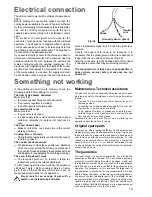
10
the piece has a strip of fat on one side only, put it in
the oven with this side upwards; when melting the fat
will grease the lower side sufficiently.
Red meat should be removed from the fridge one hour
before cooking otherwise the sudden change of tempe-
rature could cause it to become tough. A roast,
especially if of red meat, must not be salted at the
beginning of cooking as salt causes juices and blood to
seep out of the òmeat, thus preventing the formation of
a well-browned crust.
It is advisable to salt the outside of the meat after just
over half the cooking time.
Place the roast in the oven in a dish having a low rim; a
deep dish shields heat.
Meat can be placed on an ovenproof dish or directly on
the grill, under which the dripping pan will be inserted to
collect juice. Ingredients for gravy should only be put in
the dish immediately if cooking time is brief, otherwise
they should be added during the last half hour.
Begin cooking rare meat at a high temperature, reducing
the temperature to finish cooking the inside.
The cooking temperature for white meat can be mode-
rate throughout.
The degree of cooking can be checked by pressing the
meat with a fork; if it does not give the meat is cooked.
At the end of cooking it is advisable to wait at least 15
minutes before cutting the meat in order that the juices
are not lost.
Before serving plates can be kept warm in the oven at
minimum temperature.
For the cooking of fish:
Cook small fish from start to finish at a high temperatu-
re. Cook medium-sized fish initially at a high tempera-
ture and then gradually lower the temperature.
Cook large fish at a moderate temperature from start to
finish.
Check that baked fish is cooked by gently lifting one side
of the gut; the meat must be white and opaque
throughout, except in the case of salmon, trout or
similar.
Grilling
The following types of meat are suitable for grilling.
Mostly meat or offal cut in slices or pieces of various
sizes, but not usually very thick, poultry cut in half and
flattened, fish, some vegetables (e.g. courgettes,
aubergines, tomatoes, etc.), skewers of meat or fish and
seafood.
Meat and fish to be grilled should be lightly brushed with
oil and always placed on the grill; meat should be salted
upon completion of cooking; whereas fish should be
salted on the inside before cooking. The grill should be
positioned in the guides nearest or furthest from the grill
element according to the thickness of the meat, in order
to avoid burning the surface and cooking the inside
insufficiently.
The formation of smoke caused by drops of juice and
fat can be avoided by pouring l or 2 glasses of water
into the dripping pan.
The grill can also be used to brown, toast bread and grill
certain types of fruit, such as bananas, halved grapefruit,
slices of pineapple, apples, etc. Fruit should not be
placed too near the source of heat.
Cooking times
Cooking times can vary according to the type of food,
its consistency and its volume. It is advisable to watch
when cooking for the first time and check results since
when preparing the same dishes, in the same
conditions, similar results are obtained.
The TABLE OF COOKING TIMES relating to cooking
in the oven and by grill is provided as a guide.
Experience will show possible variations to the values
set out in the table.
Nevertheless carefully follow the indications given
in the receipe you intend to follow.
Attention
: do not place any utensils such as dripping
pan, cake tins, casseroles, pyrex dishes, aluminium foil
or other on the base of the oven when the oven is in use.
A stagnation of heat would result which would compro-
mise the results of cooking and could damage the oven
enamel.





































